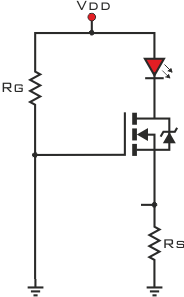I am trying to turn an LED on and off repeatedly with a square wave.
Yesterday, I've checked the following circuit works:

(Please note that, the figure has one voltage source Vdd. But I've connected a square wave source to the resistor Rg)
But, the most of LED driving circuits have a form of the following:

I am curious that what roll a BJT does in this circuit. From this article, it has something to do with a constant current source. Then, what is an advantage if there is a constant current source?
